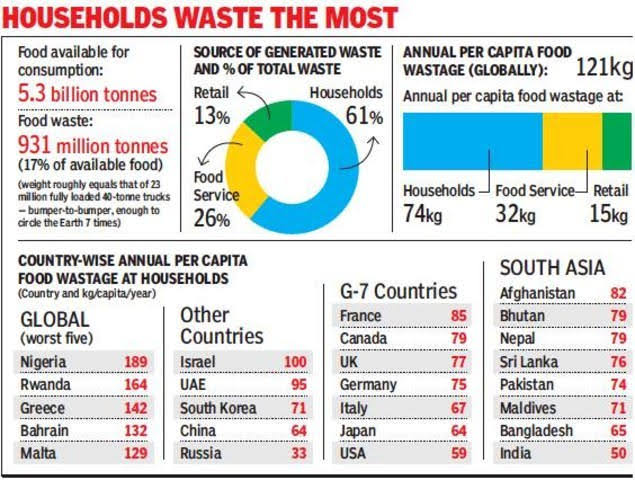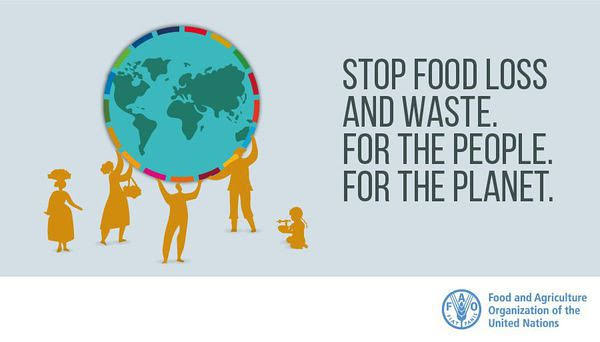Nobody buys food with the intention to throw it in the bin, it’s just the small quantities of food which are thrown away as “waste”, from uneaten leftovers to spoiled produce and no one is bothered when these small quantities add up to the annual food wastage of 1billion tonnes.
On the other hand, not even a single being on the planet deserves to die of hunger or suffer acute malnutrition because of inability to arrange basic nutrition.
Therefore as humans, we may dream of a World without Hunger as mentioned in our Sustainable Development Goals:
SDG 2: complete elimination of Hunger
SDG 12: responsible consumption and production
Further SDG 12.3 aims to halve the food wastage by 2030
![]()
Fulfilment of these hunger related SDGs may indirectly influence the other SDGs like Goal 3(good health and well being) and Goal 10(Reducing Inequality).
Even a broader goal like SDG 5(gender equality) may be corrected as according to The Food and Agriculture Organization based on the findings of GHI has rightly argued, “More often than not, the face of malnutrition is female.”
About the Food Index:

The report presents the most comprehensive food waste data collection, analysis and modelling, generating a new estimate of global food waste as well as publishes a methodology for countries to measure food waste at all levels: household, food service and retail level, in order to track national progress towards 2030 and to report on SDG 12.3.
It is important and equally disheartening to note that an estimated 8-10 per cent of the global greenhouse gas emissions are associated alone with food that is not put to consumption at all and yet none of the Nationally Determined Contributions to the Paris Agreement mention food waste.
According to the recent findings by UNEP Food Waste Index Report 2021, approximately 74kg of food is discarded annually by any single household worldwide.
The same data highlights that the percentage of food been wasted in restaurants and shops to be 17% of all food dumped.
Generally high-income households have higher food waste than low-income households although exceptions do exist.
How the Food Waste Index gets calculated ?
For each sector within a country, the level of ‘food waste’ will be expressed as an index relative to the level of food waste in the baseline year. A value of:
• 100 would indicate the same level of food waste in that sector as the baseline year.
• 50 would indicate that food waste in that sector had halved since the baseline year, consistent with the target of SDG 12.3
The indices for each sector will not be combined into a single Food Waste Index.
Market triggered wastage:
There are abundant reasons which contributes to the food wastage and consequently influences the consumer habits.
For example the offers in restaurants “all-you-can-eat-buffets or buy-one get-one”, all these encourages the consumer to buy more than they can consume.
Rigorous standards which ultimately lead to assigning the grades to different fruits and vegetables based on its characteristic quality, shape, size etc may lead to under utilization of already scarce food resource.
According to the European commission total annual food wastage is EU’s 88 million tonnes which is equivalent to 173 kilos per person and approximately 10% of this proportion is because of date labelling.
Even misinterpretation of labels like “best before”, convince the consumers to have “best” quality of food in their refrigerators.
This ultimately discourages them to opt for such foods with lesser shelf life and in turn encourages them to waste food unintentionally.

Are there any consequences involved?
Furthermore, food waste or loss drives global pollution as it causes about 10% of the emissions subsequently adding to the climate emergency.
At times the waste food is not reclaimed properly or composting is not undertaken. This can itself trigger several hazardous environmental consequences like releasing of landfill gas from the anaerobic digestion of organic matter which is the main source of greenhouse gas.
Biodiversity loss is another bigger concern that gets indirectly affected by such waste. More waste calls for more foodgrain production which in turn leads to more agricultural exploitation and original habitat loss affecting the land use planning for the time being.
Not only this but also it defeats the effort to provide aid to the billions of people who are starving.
India ranks 94th among 107 countries in Global Hunger Index with 14% of it’s population estimated to be undernourished, which constitutes 60% of women and children.
Furthermore, diseases like wasting and stunting are highly common in children.
Almost every year there are cases of litchi deaths in northern India, where the hungry children contract acute encephalitis syndrome. It does not only point out the lack of implementation process but also the historical class-caste barrier in India.
Why not try a few good things when options are available like recycle in better and responsible ways, use these wastes to produce others, rotten foods can serve essentially in the manufacture of Biofuels and above all at home practise 3Rs: Reduce, Reuse, Recycle.
Food wastage simply topples the concerted economic and social welfare efforts by the Government for all citizens especially the ones at lower strata of human society, needing special care.


